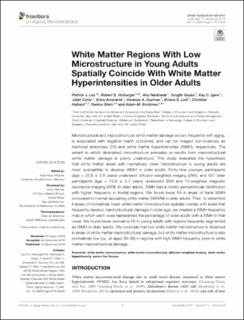Bitte benutzen Sie diese Kennung, um auf die Ressource zu verweisen:
https://doi.org/10.21256/zhaw-19129| Publikationstyp: | Beitrag in wissenschaftlicher Zeitschrift |
| Art der Begutachtung: | Peer review (Publikation) |
| Titel: | White matter regions with low microstructure in young adults spatially coincide with white matter hyperintensities in older adults |
| Autor/-in: | Lao, Patrick J. Vorburger, Robert S. Narkhede, Atul Gazes, Yunglin Igwe, Kay C. Colón, Juliet Amarante, Erica Guzman, Vanessa A. Last, Briana S. Habeck, Christian Stern, Yaakov Brickman, Adam M. |
| et. al: | No |
| DOI: | 10.3389/fnagi.2019.00345 10.21256/zhaw-19129 |
| Erschienen in: | Frontiers in Aging Neuroscience |
| Band(Heft): | 11 |
| Heft: | 345 |
| Erscheinungsdatum: | 10-Dez-2019 |
| Verlag / Hrsg. Institution: | Frontiers Research Foundation |
| ISSN: | 1663-4365 |
| Sprache: | Englisch |
| Schlagwörter: | Magnetic resonance imaging; Aging; White matter hyperintensities |
| Fachgebiet (DDC): | 610: Medizin und Gesundheit |
| Zusammenfassung: | Microstructural and macrostructural white matter damage occurs frequently with aging, is associated with negative health outcomes, and can be imaged non-invasively as fractional anisotropy (FA) and white matter hyperintensities (WMH), respectively. The extent to which diminished microstructure precedes or results from macrostructural white matter damage is poorly understood. This study evaluated the hypothesis that white matter areas with normatively lower microstructure in young adults are most susceptible to develop WMH in older adults. Forty-nine younger participants (age = 25.8 ± 2.8 years) underwent diffusion-weighted imaging (DWI), and 557 older participants (age = 73.9 ± 5.7 years) underwent DWI and T2-weighted magnetic resonance imaging (MRI). In older adults, WMH had a mostly periventricular distribution with higher frequency in frontal regions. We found lower FA in areas of frank WMH compared to normal-appearing white matter (NAWM) in older adults. Then, to determine if areas of normatively lower white matter microstructure spatially overlap with areas that frequently develop macrostructural damage in older age, we created a WMH frequency map in which each voxel represented the percentage of older adults with a WMH in that voxel. We found lower normative FA in young adults with regions frequently segmented as WMH in older adults. We conclude that low white matter microstructure is observed in areas of white matter macrostructural damage, but white matter microstructure is also normatively low (i.e., at ages 20–30) in regions with high WMH frequency, prior to white matter macrostructural damage. |
| URI: | https://digitalcollection.zhaw.ch/handle/11475/19129 |
| Volltext Version: | Publizierte Version |
| Lizenz (gemäss Verlagsvertrag): | CC BY 4.0: Namensnennung 4.0 International |
| Departement: | Life Sciences und Facility Management |
| Organisationseinheit: | Institut für Computational Life Sciences (ICLS) |
| Enthalten in den Sammlungen: | Publikationen Life Sciences und Facility Management |
Dateien zu dieser Ressource:
| Datei | Beschreibung | Größe | Format | |
|---|---|---|---|---|
| fnagi-11-00345.pdf | 3.91 MB | Adobe PDF |  Öffnen/Anzeigen |
Zur Langanzeige
Lao, P. J., Vorburger, R. S., Narkhede, A., Gazes, Y., Igwe, K. C., Colón, J., Amarante, E., Guzman, V. A., Last, B. S., Habeck, C., Stern, Y., & Brickman, A. M. (2019). White matter regions with low microstructure in young adults spatially coincide with white matter hyperintensities in older adults. Frontiers in Aging Neuroscience, 11(345). https://doi.org/10.3389/fnagi.2019.00345
Lao, P.J. et al. (2019) ‘White matter regions with low microstructure in young adults spatially coincide with white matter hyperintensities in older adults’, Frontiers in Aging Neuroscience, 11(345). Available at: https://doi.org/10.3389/fnagi.2019.00345.
P. J. Lao et al., “White matter regions with low microstructure in young adults spatially coincide with white matter hyperintensities in older adults,” Frontiers in Aging Neuroscience, vol. 11, no. 345, Dec. 2019, doi: 10.3389/fnagi.2019.00345.
LAO, Patrick J., Robert S. VORBURGER, Atul NARKHEDE, Yunglin GAZES, Kay C. IGWE, Juliet COLÓN, Erica AMARANTE, Vanessa A. GUZMAN, Briana S. LAST, Christian HABECK, Yaakov STERN und Adam M. BRICKMAN, 2019. White matter regions with low microstructure in young adults spatially coincide with white matter hyperintensities in older adults. Frontiers in Aging Neuroscience. 10 Dezember 2019. Bd. 11, Nr. 345. DOI 10.3389/fnagi.2019.00345
Lao, Patrick J., Robert S. Vorburger, Atul Narkhede, Yunglin Gazes, Kay C. Igwe, Juliet Colón, Erica Amarante, et al. 2019. “White Matter Regions with Low Microstructure in Young Adults Spatially Coincide with White Matter Hyperintensities in Older Adults.” Frontiers in Aging Neuroscience 11 (345). https://doi.org/10.3389/fnagi.2019.00345.
Lao, Patrick J., et al. “White Matter Regions with Low Microstructure in Young Adults Spatially Coincide with White Matter Hyperintensities in Older Adults.” Frontiers in Aging Neuroscience, vol. 11, no. 345, Dec. 2019, https://doi.org/10.3389/fnagi.2019.00345.
Alle Ressourcen in diesem Repository sind urheberrechtlich geschützt, soweit nicht anderweitig angezeigt.